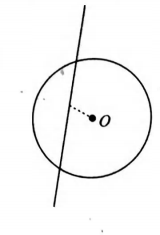Q.
A uniformly charged and infinitely long line having a liner charge density $\lambda$ is placed at a normal distance $y$ from a point $O$. Consider a sphere of radius $R$ with $O$ as the center and $R > y$. Electric flux through the surface of the sphere is
Electrostatic Potential and Capacitance
Report Error
Solution:
Electric flux $∮\limits_S \vec{E} \cdot \vec{d} s = \frac{q_{in}}{\varepsilon_0}$

$q_{in}$ is the charge enclosed by the Gaussian surface, which, in the present case, is the surface of the given sphere. As shown, length $AB$ of line lies inside the sphere. In $\Delta OO' A$,
$R^2 = Y^2 + (O'A)^2$
$\therefore O'A = \sqrt{R^2 - y^2}$
and $AB = 2\sqrt{R^2 - y^2}$
Charge on length $AB$ is $2\sqrt{R^2 - y^2} \times \lambda$
Therefore, electric flux is
$∮\limits_S \vec{E} \cdot \vec{d} s = \frac{2\lambda\sqrt{R^2 - y^2}}{\varepsilon_0}$
Questions from Electrostatic Potential and Capacitance
Physics Most Viewed Questions
1. If $E$ and $G$ respectively denote energy and gravitational constant, then $\frac{ E }{ G }$ has the dimensions of:
NEET 2021
Physical World, Units and Measurements
2. The de Broglie wavelength of an electron moving with kinetic energy of $144 \,eV$ is nearly
NEET 2020
Dual Nature of Radiation and Matter
3. A car starts from rest and accelerates at $5\, m / s ^{2}$ At $t=4\, s$, a ball is dropped out of a window by a person sitting in the car. What is the velocity and acceleration of the ball at $t =6\, s$ ? (Take $\left. g =10\, m / s ^{2}\right)$
NEET 2021
Motion in a Straight Line
Latest Updates
- JEE Main 2023 February 25th Shift 1 Morning
- JEE Main 2023 February 25th Shift 2 Evening
- JEE Main 2023 January 31st Shift 1 Morning
- JEE Main 2023 January 31st Shift 2 Evening
- JEE Main 2023 January 30th Shift 1 Morning
- JEE Main 2023 January 30th Shift 2 Evening
- JEE Main 2023 January 25th Shift 1 Morning
- JEE Main 2023 January 25th Shift 2 Evening
- JEE Main 2023 January 24th Shift 1 Morning
- JEE Main 2023 January 24th Shift 2 Evening
- JEE Main 2023 February 1st Shift 1 Morning
- JEE Main 2023 February 1st Shift 2 Evening
- JEE Main 2022 July 25th Shift 1 Morning
- JEE Main 2022 July 25th Shift 2 Evening
- JEE Main 2022 July 26th Shift 1 Morning
- JEE Main 2022 July 28th Shift 1 Morning
- JEE Advanced 2022 Paper 2
- JEE Advanced 2022 Paper 1
- JEE Advanced 2021 Paper 2
- JEE Advanced 2021 Paper 1
- JEE Advanced 2020 Paper 2
- JEE Advanced 2020 Paper 1
- NEET 2022 Physics Answer Key
- NEET 2022 Chemistry Answer Key
- NEET 2022 Botany Biology Answer Key
- NEET 2022 Zoology Biology Answer Key
- NEET Rank Predictor 2023
